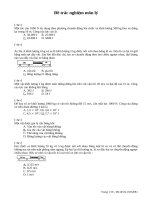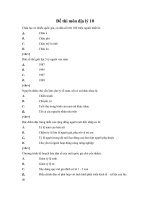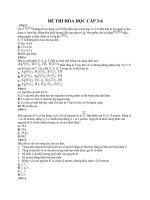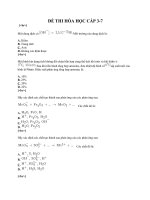- Trang chủ >>
- Đề thi >>
- Đề thi tuyển dụng
Đề thi trắc nghiệm môn C sharp (5)
Bạn đang xem bản rút gọn của tài liệu. Xem và tải ngay bản đầy đủ của tài liệu tại đây (634.01 KB, 10 trang )
Câu hỏi trắc nghiệm C# bằng tiếng anh có đáp án
41
1. By value
2. By reference
3. By address
4. By position
5. By name
A.
1, 2
B.
1, 2, 3
C.
4, 5
D.
All of the above
4. Which of the following statements are correct about inspecting an attribute in
C#.NET?
1. An attribute can be inspected at link-time.
2. An attribute can be inspected at compile-time.
3. An attribute can be inspected at run-time.
4. An attribute can be inspected at design-time.
A.
1, 2
B.
3, 4
C.
1, 3, 4
D.
All of the above
E.
None of the above
5. Which of the following is correct ways of applying an attribute?
A.
[WebService (Name = "IndiaBIX", Description = "BIX WebService")]
class AuthenticationService: WebService
{ /* */}
B.
<WebService ( Name : "IndiaBIX", Description : "BIX WebService" )>
class AuthenticationService: inherits WebService
{ /* */}
C.
<WebService ( Name = "IndiaBIX", Description = "BIX WebService" )>
class AuthenticationService: extends WebService
{ /* */}
Câu hỏi trắc nghiệm C# bằng tiếng anh có đáp án
42
D.
[WebService ( Name := "IndiaBIX", Description := "BIX WebService")]
class AuthenticationService: inherits WebService
{ /* */}
6. Which of the following statements are correct about Attributes used in C#.NET?
A.
If there is a custom attribute BugFixAttribute then the compiler will look ONLY for
the BugFix attribute in the code that uses this attribute.
B.
To create a custom attribute we need to create a custom attribute structure and derive it
from System.Attribute.
C.
To create a custom attribute we need to create a class and
implementIAttribute interface in it.
D.
If a BugFixAttribute is to receive three parameters then theBugFixAttribute class
should implement a zero-argument constructor.
E.
The CLR can change the behaviour of the code depending upon the attributes
applied to it.
7. Which of the following forms of applying an attribute is correct?
A.
< Serializable() > class sample
{ /* */ }
B.
(Serializable()) class sample
{ /* */ }
C.
[ Serializable() ] class sample
{ /* */ }
D.
Serializablef) class sample
{ /* */ }
E.
None of the above
Câu hỏi trắc nghiệm C# bằng tiếng anh có đáp án
43
8. Which of the following statements are correct about Attributes in C#.NET?
1. On compiling a C#.NET program the attibutes applied are recorded in the metadata of the
assembly.
2. On compilation all the attribute's tags are deleted from the program.
3. It is not possible to create custom attributes
4. The attributes applied can be read from an assembly using Reflection class.
5. An attribute can have parameters.
A.
1 and 2 only
B.
2 and 4 only
C.
1, 4 and 5 only
D.
All of the above
E.
None of the above
9. Which of the following correctly describes the contents of the filename AssemblyInfo.cs?
A.
It contains method-level attributes.
B.
It contains class-level attributes.
C.
It contains assembly-level attributes.
D.
It contains structure-level attributes.
E.
It contains namespace-level attributes.
10. It possible to create a custom attribute that can be applied only to specific programming
element(s) like ____ .
A.
Classes
B.
Methods
C.
Classes and Methods
D.
Classes, Methods and Member-Variables
11. Which of the following CANNOT be a target for a custom attribute?
A.
Enum
B.
Event
C.
Delegate
D.
Interface
E.
Namespace
12. Once applied which of the following CANNOT inspect the applied attribute?
Câu hỏi trắc nghiệm C# bằng tiếng anh có đáp án
44
A.
CLR
B.
Linker
C.
ASP.NET Runtime
D.
Visual Studio.NET
E.
Language compilers
13. Which of the following is the correct way to apply an attribute to an Assembly?
A.
[ AssemblyDescription("DCube Component Library") ]
B.
[ assembly : AssemblyDescription("DCube Component Library") ]
C.
[ Assemblylnfo : AssemblyDescription("DCube Component Library") ]
D.
< Assembly: AssemblyDescription("DCube Component Library") >
E.
(Assembly: AssemblyDescription("DCube Component Library"))
14. Which of the following is the correct way of applying the custom attribute called Tested
which receives two-arguments - name of the tester and the testgrade?
1. Custom attribute cannot be applied to an assembly.
2. [assembly: Tested("Sachin", testgrade.Good)]
3. [Tested("Virat", testgrade.Excellent)]
class customer { /* */ }
4. Custom attribute cannot be applied to a method.
5. Custom attribute cannot be applied to a class.
A.
1 only
B.
1, 5
C.
2, 3
D.
4, 5
E.
None of the above
15. Attributes can be applied to
1. Method
2. Class
3. Assembly
Câu hỏi trắc nghiệm C# bằng tiếng anh có đáp án
45
4. Namespace
5. Enum
A.
1 and 2 only
B.
1, 2 and 3
C.
4 and 5 only
D.
All of the above
Câu hỏi Contructors
1. Which of the following statements is correct?
A.
A constructor can be used to set default values and limit instantiation.
B.
C# provides a copy constructor.
C.
Destructors are used with classes as well as structures.
D.
A class can have more than one destructor.
2. Which of the following statements is correct about the C#.NET code snippet given
below?
namespace IndiabixConsoleApplication
{
class Sample
{
public int func()
{
return 1;
}
public Single func()
{
return 2.4f ;
}
}
class Program
{
static void Main(string[ ] args)
{
Sample s1 = new Sample();
int i;
i = s1.func();
Single j;
j = s1.func();
}
Câu hỏi trắc nghiệm C# bằng tiếng anh có đáp án
46
}
}
A.
func() is a valid overloaded function.
B.
Overloading works only in case of subroutines and not in case of functions.
C.
func() cannot be considered overloaded because: return value cannot be used to
distinguish between two overloaded functions.
D.
The call to i = s1.func() will assign 1 to i.
E.
The call j = s1.func() will assign 2.4 to j.
3. Which of the following ways to create an object of the Sample class given below will
work correctly?
class Sample
{
int i;
Single j;
double k;
public Sample (int ii, Single jj, double kk)
{
i = ii;
j = jj;
k = kk;
}
}
A.
Sample s1 = new Sample();
B.
Sample s1 = new Sample(10);
C.
Sample s2 = new Sample(10, 1.2f);
D.
Sample s3 = new Sample(10, 1.2f, 2.4);
E.
Sample s1 = new Sample(, , 2.5);
4. Which of the following statements are correct about static functions?
1. Static functions can access only static data.
2. Static functions cannot call instance functions.
3. It is necessary to initialize static data.
4. Instance functions can call static functions and access static data.
5. this reference is passed to static functions.
A.
1, 2, 4
B.
2, 3, 5
Câu hỏi trắc nghiệm C# bằng tiếng anh có đáp án
47
C.
3, 4
D.
4, 5
E.
None of these
5. Which of the following statements is correct about constructors?
A.
If we provide a one-argument constructor then the compiler still provides a zero-argument
constructor.
B.
Static constructors can use optional arguments.
C.
Overloaded constructors cannot use optional arguments.
D.
If we do not provide a constructor, then the compiler provides a zero-argument
constructor.
6. Which of the following is the correct way to define the constructor(s) of
the Sample class if we are to create objects as per the C#.NET code snippet given
below?
Sample s1 = new Sample();
Sample s2 = new Sample(9, 5.6f);
A.
public Sample()
{
i = 0;
j = 0.0f;
}
public Sample (int ii, Single jj)
{
i = ii;
j = jj;
}
B.
public Sample (Optional int ii = 0, Optional Single jj = 0.0f)
{
i = ii;
j = jj;
}
Câu hỏi trắc nghiệm C# bằng tiếng anh có đáp án
48
C.
public Sample (int ii, Single jj)
{
i = ii;
j = jj;
}
D.
Sample s;
7. In which of the following should the methods of a class differ if they are to be treated as
overloaded methods?
1. Type of arguments
2. Return type of methods
3. Number of arguments
4. Names of methods
5. Order of arguments
A.
2, 4
B.
3, 5
C.
1, 3, 5
D.
3, 4, 5
8. Can static procedures access instance data?
A.
Yes
B.
No
9. Which of the following statements are correct about constructors in C#.NET?
1. Constructors cannot be overloaded.
2. Constructors always have the name same as the name of the class.
3. Constructors are never called explicitly.
4. Constructors never return any value.
5. Constructors allocate space for the object in memory.
A.
1, 3, 5
B.
2, 3, 4
C.
3, 5
D.
4, 5
E.
None of these
Câu hỏi trắc nghiệm C# bằng tiếng anh có đáp án
49
10. How many times can a constructor be called during lifetime of the object?
A.
As many times as we call it.
B.
Only once.
C.
Depends upon a Project Setting made in Visual Studio.NET.
D.
Any number of times before the object gets garbage collected.
E.
Any number of times before the object is deleted.
11. Is it possible to invoke Garbage Collector explicitly?
A.
Yes
B.
No
12. Which of the following statements are correct about the C#.NET code snippet given
below?
class Sample
{
static int i;
int j;
public void proc1()
{
i = 11;
j = 22;
}
public static void proc2()
{
i = 1;
j = 2;
}
static Sample()
{
i = 0;
j = 0;
}
}
A.
i cannot be initialized in proc1().
B.
proc1() can initialize i as well as j.
C.
j can be initialized in proc2().
D.
The constructor can never be declared as static.
E.
proc2() can initialize i as well as j.
Câu hỏi trắc nghiệm C# bằng tiếng anh có đáp án
50
13. Which of the following statements is correct?
A.
There is one garbage collector per program running in memory.
B.
There is one common garbage collector for all programs.
C.
An object is destroyed by the garbage collector when only one reference refers to it.
D.
We have to specifically run the garbage collector after executing Visual Studio.NET.
14. Is it possible for you to prevent an object from being created by using zero argument
constructor?
A.
Yes
B.
No
15. Which of the following statements are correct about static functions?
A.
Static functions are invoked using objects of a class.
B.
Static functions can access static data as well as instance data.
C.
Static functions are outside the class scope.
D.
Static functions are invoked using class.
16. What will be the output of the C#.NET code snippet given below?
namespace IndiabixConsoleApplication
{
class Sample
{
static Sample()
{
Console.Write("Sample class ");
}
public static void Bix1()
{
Console.Write("Bix1 method ");
}
}
class MyProgram
{
static void Main(string[ ] args)
{
Sample.Bix1();
}
}
}
A.
Sample class Bix1 method
B.
Bix1 method









